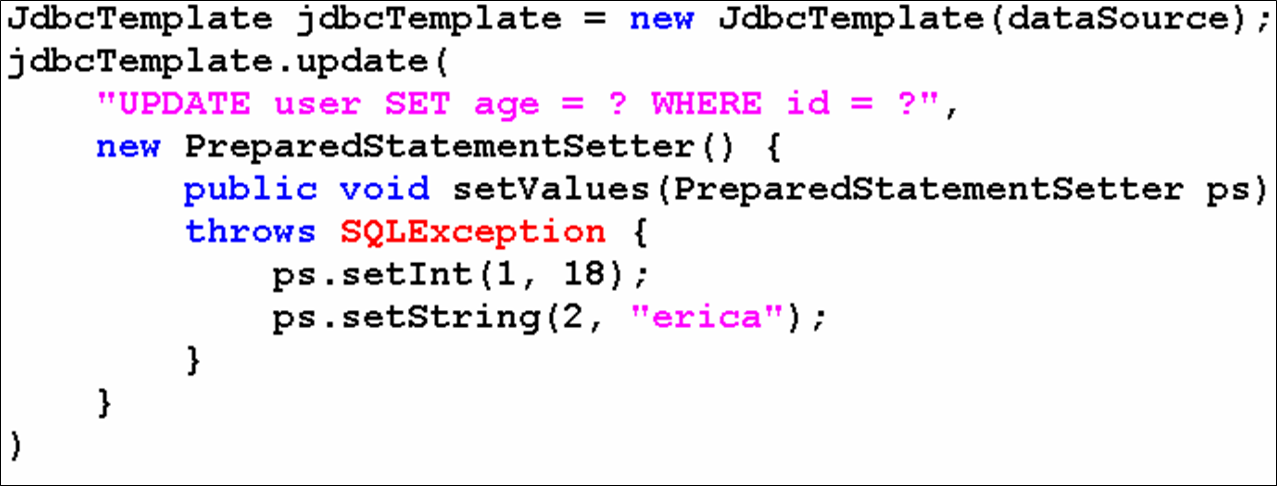近日,在研究 Spring ,看到模板方法有这样一段代码:

一时没有搞明白,经过仔细研究 发现可以用内部类来实现,而Spring
时用接口来实现的。以下时我写的内部类的实现方法:
mysql:
 create
database
school;
create
database
school;
 use
school;
use
school;
 create
table
student
create
table
student (
( stu_id
int
not
null
primary
key
,
stu_id
int
not
null
primary
key
, stu_name
varchar
(
20
)
not
null
,
stu_name
varchar
(
20
)
not
null
, stu_age
int
stu_age
int
 );
);
 select
*
from
student;
select
*
from
student;
applicationContext.xml:
 <?
xml version="1.0" encoding="UTF-8"
?>
<?
xml version="1.0" encoding="UTF-8"
?>
 <!
DOCTYPE beans PUBLIC "-//SPRING//DTD BEAN//EN" "http://www.springframework.org/dtd/spring-beans.dtd"
>
<!
DOCTYPE beans PUBLIC "-//SPRING//DTD BEAN//EN" "http://www.springframework.org/dtd/spring-beans.dtd"
>

 <
beans
>
<
beans
>
 <
bean
id
="dataSource"
<
bean
id
="dataSource"
 class
="org.apache.commons.dbcp.BasicDataSource"
>
class
="org.apache.commons.dbcp.BasicDataSource"
>
 <
property
name
="driverClassName"
>
<
property
name
="driverClassName"
>
 <
value
>
com.mysql.jdbc.Driver
</
value
>
<
value
>
com.mysql.jdbc.Driver
</
value
>
 </
property
>
</
property
>
 <
property
name
="url"
>
<
property
name
="url"
>
 <
value
>
jdbc:mysql:///school
</
value
>
<
value
>
jdbc:mysql:///school
</
value
>
 </
property
>
</
property
>
 <
property
name
="username"
>
<
property
name
="username"
>
 <
value
>
root
</
value
>
<
value
>
root
</
value
>
 </
property
>
</
property
>
 </
bean
>
</
bean
>
 </
beans
>
</
beans
>
DriverManager.java
 package
test;
package
test;
 import
javax.sql.DataSource;
import
javax.sql.DataSource;
 import
org.springframework.context.ApplicationContext;
import
org.springframework.context.ApplicationContext; import
org.springframework.context.support.ClassPathXmlApplicationContext;
import
org.springframework.context.support.ClassPathXmlApplicationContext;

 public
class
DriverManager
...
{
public
class
DriverManager
...
{
 public DataSource getDataSource() ...{
public DataSource getDataSource() ...{ ApplicationContext context = new ClassPathXmlApplicationContext(
ApplicationContext context = new ClassPathXmlApplicationContext( "applicationContext.xml");
"applicationContext.xml");
 javax.sql.DataSource dataSource = (DataSource) context
javax.sql.DataSource dataSource = (DataSource) context .getBean("dataSource");
.getBean("dataSource");
 return dataSource;
return dataSource;
 }
}

 public static void main(String[] args) ...{
public static void main(String[] args) ...{ javax.sql.DataSource d = new DriverManager().getDataSource();
javax.sql.DataSource d = new DriverManager().getDataSource();
 System.out.println(d);
System.out.println(d); }
} }
}
JdbcTemplate.java
 package
test;
package
test;
 import
java.sql.PreparedStatement;
import
java.sql.PreparedStatement; import
java.sql.SQLException;
import
java.sql.SQLException;
 import
javax.sql.DataSource;
import
javax.sql.DataSource;

 public
class
JdbcTemplate
...
{
public
class
JdbcTemplate
...
{ private DataSource dataSource;
private DataSource dataSource;

 public JdbcTemplate(DataSource dataSource) ...{
public JdbcTemplate(DataSource dataSource) ...{ super();
super(); this.dataSource = dataSource;
this.dataSource = dataSource; }
}

 static class PreparedStatementSetter ...{
static class PreparedStatementSetter ...{ protected java.sql.PreparedStatement pstmt;
protected java.sql.PreparedStatement pstmt;

 public void setValues(PreparedStatement pstmt) throws SQLException ...{
public void setValues(PreparedStatement pstmt) throws SQLException ...{ this.pstmt = pstmt;
this.pstmt = pstmt; }
} }
}

 public void insert(String sql, PreparedStatementSetter pss) ...{
public void insert(String sql, PreparedStatementSetter pss) ...{
 try ...{
try ...{ java.sql.Connection con = dataSource.getConnection();
java.sql.Connection con = dataSource.getConnection(); java.sql.PreparedStatement pstmt = con.prepareStatement(sql);
java.sql.PreparedStatement pstmt = con.prepareStatement(sql);

 try ...{
try ...{ pss.setValues(pstmt);
pss.setValues(pstmt);
 } catch (Exception e) ...{
} catch (Exception e) ...{ // TODO 自动生成 catch 块
// TODO 自动生成 catch 块 e.printStackTrace();
e.printStackTrace(); }
} pstmt.executeUpdate();
pstmt.executeUpdate();
 pstmt.close();
pstmt.close(); con.close();
con.close();

 } catch (Exception e) ...{
} catch (Exception e) ...{ // TODO 自动生成 catch 块
// TODO 自动生成 catch 块 e.printStackTrace();
e.printStackTrace(); }
}
 }
}

 public static void main(String[] args) ...{
public static void main(String[] args) ...{
 DriverManager d = new DriverManager();
DriverManager d = new DriverManager(); javax.sql.DataSource dataSource = d.getDataSource();
javax.sql.DataSource dataSource = d.getDataSource();
 JdbcTemplate template = new JdbcTemplate(dataSource);
JdbcTemplate template = new JdbcTemplate(dataSource);
 String sql = "insert into student values (?,?,?)";
String sql = "insert into student values (?,?,?)";

 template.insert(sql, new PreparedStatementSetter() ...{
template.insert(sql, new PreparedStatementSetter() ...{
 public void setValues(PreparedStatement pstmt) ...{
public void setValues(PreparedStatement pstmt) ...{
 try ...{
try ...{ pstmt.setInt(1, 1112);
pstmt.setInt(1, 1112); pstmt.setString(2, "aaaaaaaaaa");
pstmt.setString(2, "aaaaaaaaaa"); pstmt.setInt(3, 19);
pstmt.setInt(3, 19);
 } catch (Exception e) ...{
} catch (Exception e) ...{ // TODO 自动生成 catch 块
// TODO 自动生成 catch 块 e.printStackTrace();
e.printStackTrace(); }
}
 }
} });
}); }
}
 }
}

最后
以上就是内向短靴最近收集整理的关于带参数模版方法实现机制的全部内容,更多相关带参数模版方法实现机制内容请搜索靠谱客的其他文章。
本图文内容来源于网友提供,作为学习参考使用,或来自网络收集整理,版权属于原作者所有。








发表评论 取消回复